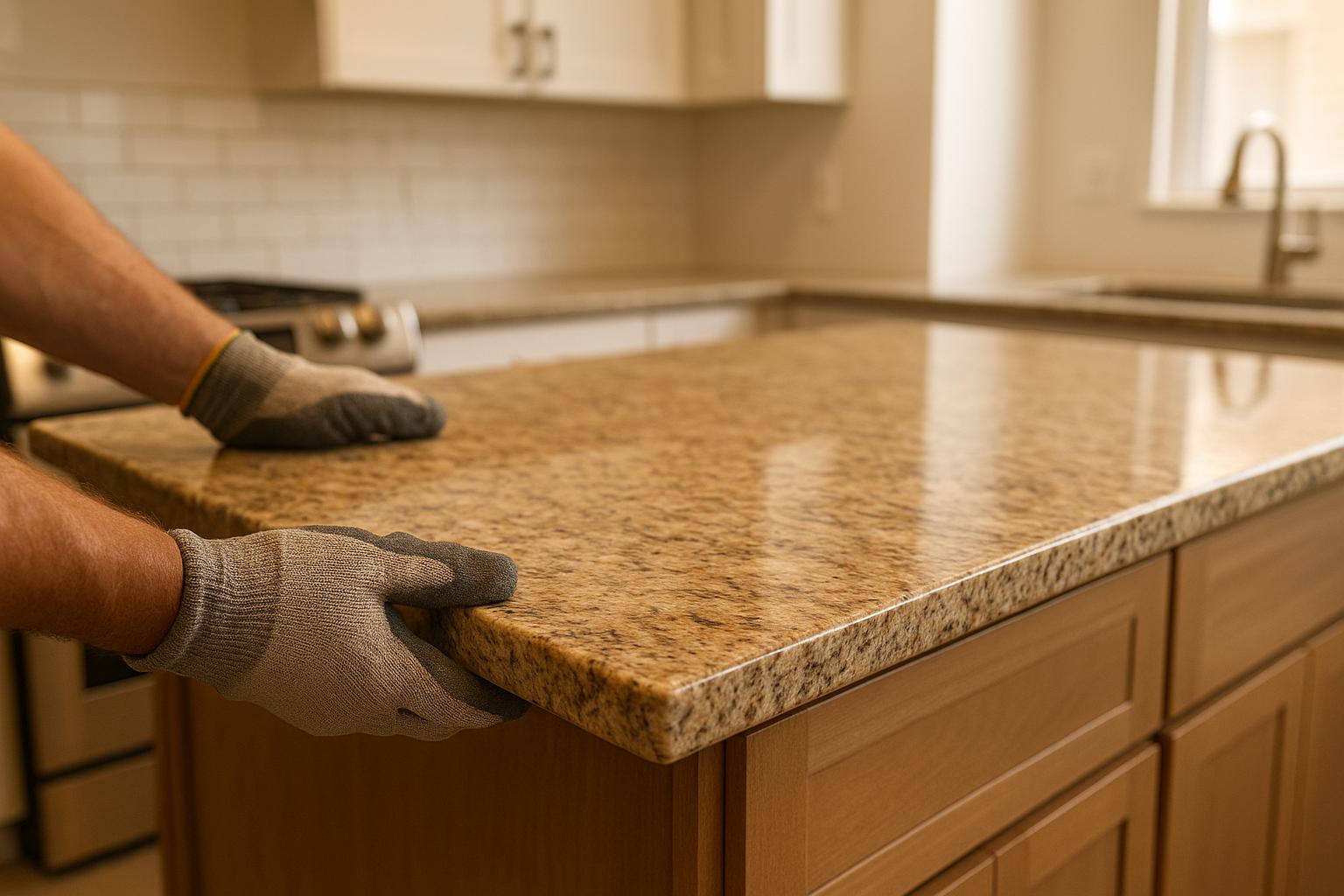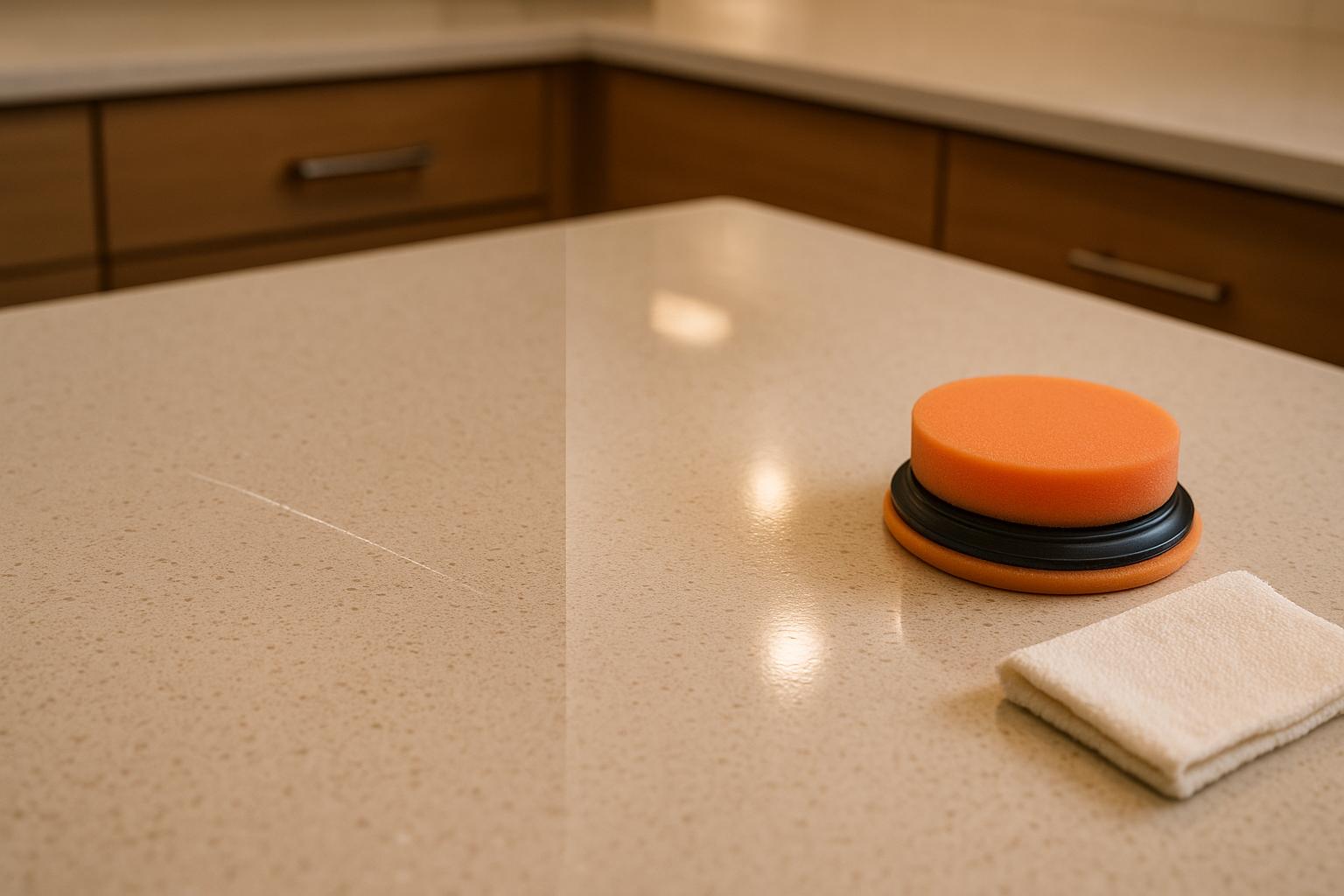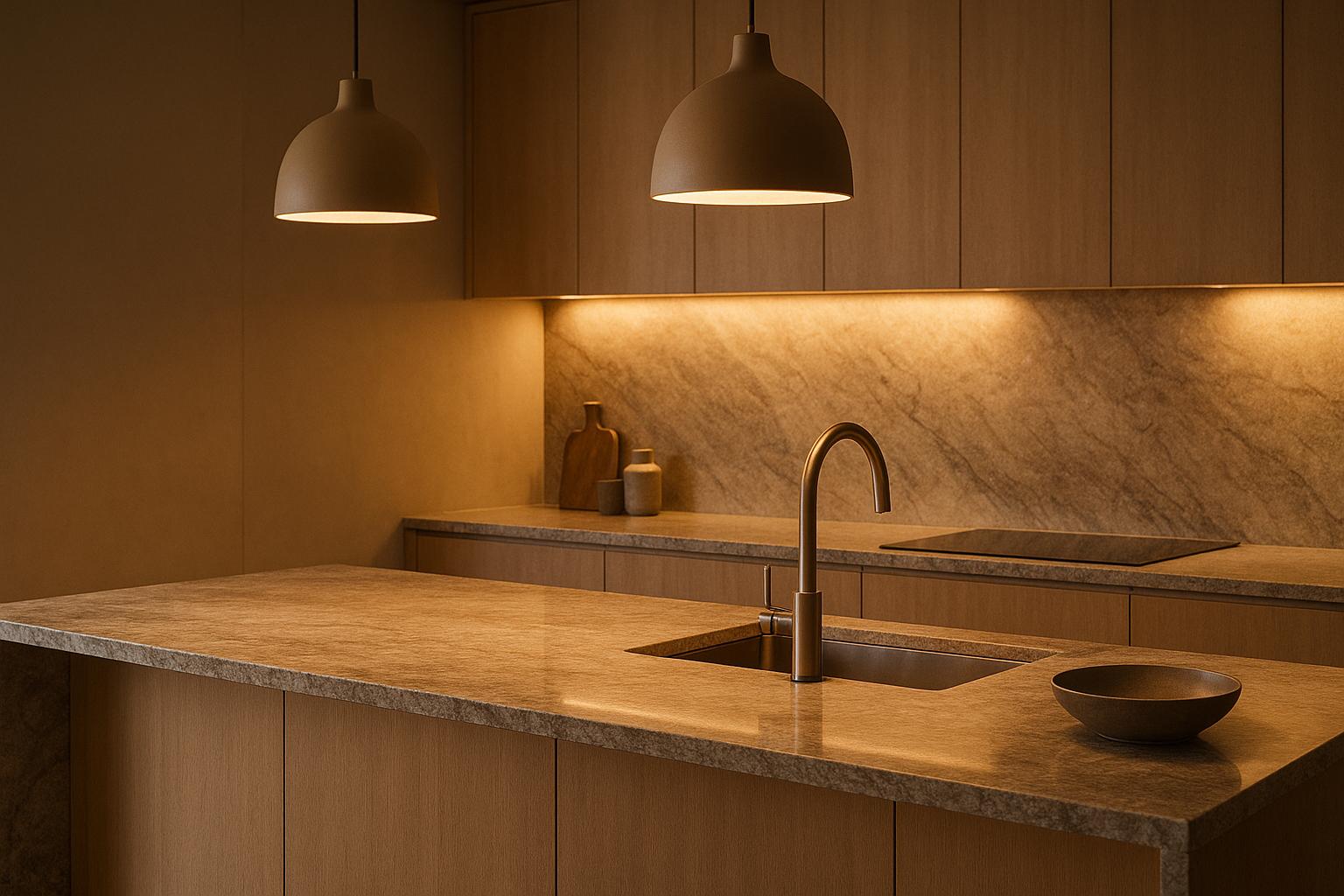Stone countertops can elevate your kitchen’s style and functionality, but their installation process involves careful planning and execution. Here’s what you need to know:
- Preparation is Key: Install cabinets, appliances, and sinks before the countertop installation. Clear the workspace and ensure all fixtures are on-site.
- Installation Timeline: It usually takes 2–3 weeks from measurement to completion, depending on the stone type and kitchen layout.
- Stone Options: Popular choices include granite (durable, natural look), quartz (low maintenance, modern), marble (elegant but delicate), onyx (visually striking), and porcelain (thin, stain-resistant).
- Care and Maintenance: Natural stones like granite and marble need regular sealing, while quartz and porcelain are easier to maintain.
Professional installation ensures precise fitting, safety, and longevity. Companies like MI Stone offer expert services and ongoing support to keep your countertops in great condition.
How to Install a Quartz Countertop | Ask This Old House

How to Prepare for Stone Countertop Installation
Getting ready for a stone countertop installation is all about planning ahead. A little preparation can help avoid delays and make the process smooth and hassle-free. Here’s what you need to know to kick things off the right way.
What Homeowners Should Do Before Installation
Before the installers arrive, make sure all foundational elements are in place. Cabinets, appliances, and drawers need to be installed in their final positions. This includes base cabinets, dishwashers, refrigerators, and any built-in appliances that will sit near or under the countertops.
Take time to clear off existing countertops and empty out any under-sink cabinets. Remove anything fragile or in the way, and secure overhead items that might fall during the installation process.
Another crucial step? Have all appliances, sinks, and faucets on-site. Installers rely on these items to make precise measurements and cuts. Missing fixtures can bring the entire process to a halt.
Lastly, keep the kitchen space clear and clutter-free. This not only makes the work easier but also ensures safety during the installation process.
What to Prepare for Installation Day
On the day of the installation, there are a few key things to keep in mind:
- Ventilation is important. Open windows or use screen doors to help with any fumes that might arise during the process.
- Safety comes first. Keep family members and pets out of the kitchen while the work is being done. To avoid delays, make sure someone who can make decisions is present to address any last-minute questions or concerns.
Following these steps will help ensure the installation goes smoothly and efficiently.
The Installation Process Step by Step
Once all the prep work is done, it’s time to move on to the actual installation. Knowing what happens during each stage can help homeowners feel more confident and prepared for the process.
Delivering and Placing Stone Slabs
The installation team arrives equipped with specialized tools designed to handle the weight and bulk of stone slabs safely. These countertops are incredibly heavy, so proper lifting equipment is a must to avoid accidents or damage.
Using suction cup lifters and A-frame dollies, the team carefully moves the slabs from the delivery truck into your home. This process requires precision, as the slabs need to be navigated through doorways and around corners without scratching walls or chipping the stone.
Before setting the slabs in place, installers double-check the level of the cabinets. Even small uneven spots can lead to stress fractures in natural stone. If adjustments are needed, they use shims or fine-tune the cabinet structure to ensure everything is perfectly level.
Once the cabinets are ready, the slabs are positioned carefully, starting with the largest pieces. A small gap is left between sections to allow for seaming later on. The goal is to create a flawless, continuous surface, which begins with precise placement.
Connecting Seams and Securing Countertops
To ensure a perfect fit, the installers dry-fit the stone pieces first, making any necessary adjustments. Once aligned, seam-setting tools are used to press the pieces tightly together while a color-matched epoxy cures. This step is crucial for both the look and durability of the finished product.
When done right, the seams are almost invisible. The epoxy is mixed with stone dust or pigments to match the natural variations in the countertop, blending the joint seamlessly with the surrounding material.
After the seams are set and cured, the countertops are securely attached to the cabinets. Instead of screws, which could crack the stone, installers use construction adhesive and attachment blocks placed strategically along the cabinet edges. This method ensures a strong bond without risking damage.
Making Cutouts for Sinks and Accessories
Creating cutouts for sinks, faucets, and other fixtures requires precision tools and careful planning. Templates and water-cooled diamond blades are used to make clean, accurate cuts that align perfectly with the overall design.
For undermount sinks, the cutout is slightly smaller than the sink’s rim, allowing the countertop to provide support while keeping the sink edge hidden. Faucet holes are drilled with diamond-tipped saws to match the fixture size exactly.
Whether it’s a soap dispenser, water filter, or electrical outlet, each cutout is carefully measured and marked with removable tape before cutting begins. This attention to detail ensures each accessory fits perfectly.
Because cutting stone can produce a lot of dust, the team takes steps to protect the surrounding areas. They use proper ventilation and cover nearby surfaces to keep the space clean and minimize disruption during this phase.
Common Installation Problems and How Professionals Fix Them
Installing stone countertops can create a lot of dust, which might affect the air quality inside your home. To tackle this, professionals often use drop sheets before cutting, keeping the workspace cleaner and reducing mess.
Controlling Dust and Debris During Installation
To limit dust buildup, professionals prefer to cut stone outdoors or in areas with good ventilation. When working indoors, they rely on tools equipped with dust shrouds and Local Exhaust Ventilation (LEV) systems fitted with HEPA filters. These methods ensure the process is as clean and efficient as possible.
sbb-itb-e397dd0
Caring for Your Countertops After Installation
Take steps to protect your new stone countertops right away. Cleaning and sealing them properly helps prevent damage, stains, and scratches.
First Steps After Installation
If you’ve chosen natural stone countertops, sealing is a must. This step protects the surface from stains, scratches, and bacteria, as natural stone is porous. However, if you went with quartz countertops, you can skip this altogether. Quartz is an engineered material that doesn’t require sealing, and applying a sealer could actually harm it.
Start by clearing and cleaning the countertops using a cleaner made specifically for stone. For any leftover residue from the installation process, mineral spirits or acetone work well. Make sure the surface is completely dry – this usually takes about 15–30 minutes.
Next, pick the right sealer for your stone type. For granite, marble, and quartzite, a penetrating, water-based sealer is a good choice (typically priced around $17.99 for 24 fl oz). For denser granite, a solvent-based option like STONETECH Bulletproof Sealer ($31.80 for 16 oz) might be better. Remember, quartz countertops don’t need sealing.
When applying the sealer, work in small sections – about four to six square feet at a time. Spread a thin, even layer and let it absorb for 2 to 15 minutes (always follow the product’s instructions). Once the sealer has set, wipe the surface completely dry. Allow 24 to 48 hours for the sealer to fully cure before using your countertops heavily.
Long-Term Care and Maintenance
After the initial care, regular upkeep is the key to keeping your countertops in top shape. Resealing schedules depend on the type of stone: granite typically needs resealing once a year, quartzite every six months, and porous stones like marble every few months. Lighter granites may also require more frequent resealing.
To check if it’s time to reseal, try the simple water test. Pour a small puddle of water on the surface. If the stone darkens within 10 minutes or water spots remain, it’s time to reseal.
For everyday cleaning, stick to soft cloths and mild dish soap. Dry the surface after each use to prevent water spots. For tougher maintenance tasks, specialized products can help. For instance, Laticrete StoneTech Oil Stain Remover is great for deep stains, while their Soap Scum Remover works well on bathroom countertops without causing scratches. In food prep areas, StoneTech Sanitizer is a safe option to kill bacteria.
Avoid using harsh or acidic cleaners on natural stone, as they can damage the surface.
MI Stone‘s Maintenance Services

Ongoing care doesn’t just keep your countertops looking good – it also protects your investment. MI Stone offers a range of maintenance support services, from helping you choose the right products to scheduling resealing and registering warranties. Their team is available to answer questions and provide professional resealing when needed.
Regular check-ups by MI Stone technicians can make a big difference in extending the life of your countertops. They’ll assess the condition of your stone, handle resealing, and address any issues before they become costly repairs.
Different Stone Types and Installation Requirements
Once you know how to care for your countertops, the next step is selecting a stone that suits your design and functional needs. The type of stone you choose doesn’t just influence the look of your space – it also impacts installation methods and long-term performance. Each stone comes with its own set of characteristics that require specific preparation and handling.
Popular Stone Types Available
Quartz is a top choice among engineered stones. Made from 90-95% natural quartz crystals mixed with resin, it offers a sleek, consistent look. MI Stone provides a wide variety of quartz slabs, known for their natural resistance to stains.
Granite is a timeless option that showcases the beauty of natural stone. This igneous rock forms deep within the Earth, resulting in unique patterns and color variations. It’s incredibly durable thanks to its hardness but does require regular sealing to keep stains at bay.
Marble is synonymous with elegance, boasting distinctive veining that adds a touch of sophistication. As a metamorphic rock, marble is softer than granite and prone to etching when exposed to acidic substances like lemon juice or vinegar.
Onyx is all about drama and visual impact. Its translucent quality and bold veining make it a stunning choice, especially when backlit. However, onyx is softer and needs extra care during installation to avoid damage.
Porcelain is a newer contender in countertop materials. These ultra-thin slabs (usually 12mm thick) are fired at high temperatures, creating a non-porous surface that resists stains and mimics the look of natural stone.
Each stone type comes with specific installation requirements, which are outlined below.
Special Installation Needs for Each Stone Type
Quartz installation must be done in climate-controlled conditions, as temperature fluctuations can cause the material to expand or contract. Adhesives specifically designed for engineered stone are essential, and quartz should never be exposed to temperatures above 300°F. To maintain its seamless appearance, installers use color-matched adhesives for the seams.
Granite installation requires careful slab selection and alignment. Since granite is a natural material, matching the grain and patterns across pieces is critical. Its weight – approximately 18-20 pounds per square foot – necessitates sturdy cabinet support, often with additional bracing.
Marble installation involves extra precautions due to its sensitivity to acids and stains. Installers use non-acidic adhesives and sealers made specifically for marble. During installation, they must take care to avoid spills or marks, as marble stains easily.
Onyx installation is particularly delicate. This stone’s translucent nature and softness mean it often needs backing support, such as fiberglass or mesh. Handling must be done with precision to prevent cracks, and seams require exact color matching to preserve the stone’s striking appearance.
Porcelain installation presents its own challenges, as these slabs are thin and fragile. Typically available in large sizes (up to 10 feet by 5 feet), porcelain requires specialized tools for transport and placement. Because of its slim profile, installers need to ensure cabinets are perfectly level before installation.
Stone Type Comparison Chart
To help you decide which stone best fits your needs, the table below highlights key differences:
| Stone Type | Durability | Maintenance Needs | Aesthetic Qualities |
|---|---|---|---|
| Quartz | High | Low | Modern and Uniform |
| Granite | High | Medium | Natural and Varied |
| Marble | Medium | High | Luxurious and Elegant |
| Onyx | Medium | High | Bold and Translucent |
| Porcelain | High | Low | Versatile and Customizable |
Durability refers to how well each stone resists scratches, chips, and heat. Quartz and porcelain rank highest due to their engineered properties, while granite’s natural hardness also makes it a durable choice. Marble and onyx, while beautiful, require more gentle handling to avoid damage.
Maintenance needs differ widely. Quartz and porcelain are low-maintenance, needing only simple cleaning with soap and water. Granite requires annual sealing and regular cleaning with stone-safe products. Marble and onyx demand more attention, including frequent sealing and immediate cleanup of spills to prevent stains.
Aesthetic qualities highlight what makes each stone visually appealing. Quartz offers clean, consistent patterns ideal for modern designs. Granite’s natural variations suit traditional or rustic styles. Marble exudes timeless luxury, onyx makes a bold statement, and porcelain can mimic virtually any natural stone, offering unmatched versatility in design options.
Conclusion
Installing stone countertops requires careful planning, skilled installation, and ongoing care to maintain their beauty and durability. Each step matters – whether it’s preparing the space, ensuring proper support for heavy slabs, or handling different types of stone like quartz, granite, marble, onyx, or porcelain. These details come together to create a flawless and long-lasting kitchen centerpiece.
Professional installers play a crucial role in addressing challenges like precise fitting, seam alignment, and managing dust during the process. Their expertise ensures your countertops are not only visually stunning but also structurally sound.
For over 30 years, MI Stone has been a trusted name in stone restoration, repair, and preservation across Metro Detroit and beyond. Customers frequently share glowing reviews, calling their experience "great" and the service "amazing." Many commend Chris and his team for their "knowledge, attention to detail", and overall professionalism. From the initial consultation to the final installation, MI Stone is dedicated to delivering countertops that boost your home’s value while offering the durability and elegance you expect from premium stone surfaces.
Ready to transform your kitchen? Reach out to MI Stone by text or phone to schedule an appointment or request a quote.
FAQs
What should I do if my stone countertop installation is delayed because fixtures or appliances are missing?
If your stone countertop installation hits a snag because of missing fixtures or appliances, the first thing to do is talk to your contractor about adjusting the schedule. Countertops are usually installed after cabinets and key fixtures – like sinks and dishwashers – are already in place. This sequence ensures everything fits perfectly and avoids unnecessary issues.
To keep things on track, it’s smart to plan ahead. Coordinate the delivery of all required fixtures and appliances well before the installation date. But if a delay does happen, rescheduling is the best way to make sure the process stays on course and your countertops are installed without a hitch.
How can I make the seams in my stone countertops less noticeable?
To make the seams in your stone countertops less noticeable, work closely with your fabricator to align the patterns and veining across the slabs. Opting for book-matched slabs can significantly enhance the seamless appearance by creating a continuous flow in the design.
Accurate cutting and finishing are just as crucial. Fabricators often rely on advanced equipment to produce smooth, precise edges that fit together seamlessly. Using a color-matched epoxy is another effective way to blend the seam into the surrounding stone, making it less obvious.
Lastly, ensure your cabinets are perfectly level and use specialized seam-setting tools to create tight, even joints. These steps, combined with meticulous preparation, can make a big difference in achieving a polished, nearly invisible finish.
What’s the difference in maintenance between natural stone and engineered stone countertops?
Natural Stone vs. Engineered Stone Countertops
Natural stone countertops, such as granite and marble, are undeniably stunning but require a bit of extra care to keep them looking their best. These surfaces usually need to be sealed annually to protect against stains and etching. They’re also more prone to damage from heat and acidic substances, so a little extra caution is necessary. When it comes to cleaning, sticking to non-abrasive products is key to avoid wear and tear.
On the other hand, engineered stone countertops, like quartz, are built for convenience. They don’t need sealing, are less porous, and offer excellent resistance to stains and scratches. Cleaning is straightforward – just grab a mild household cleaner, and you’re good to go. This makes them a practical and durable option for busy households.
In essence, natural stone delivers unmatched elegance but asks for more attention, while engineered stone combines durability and ease of maintenance for hassle-free everyday use.



